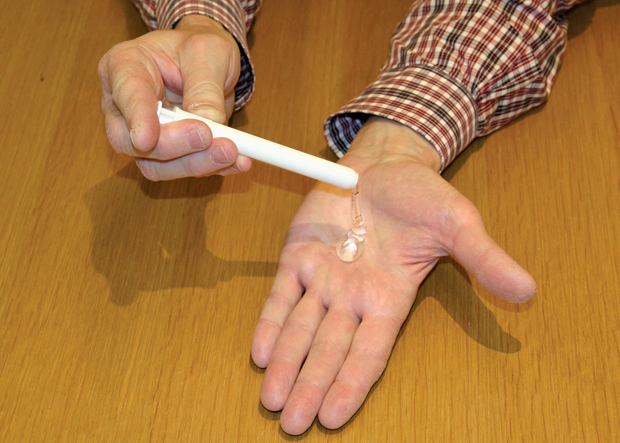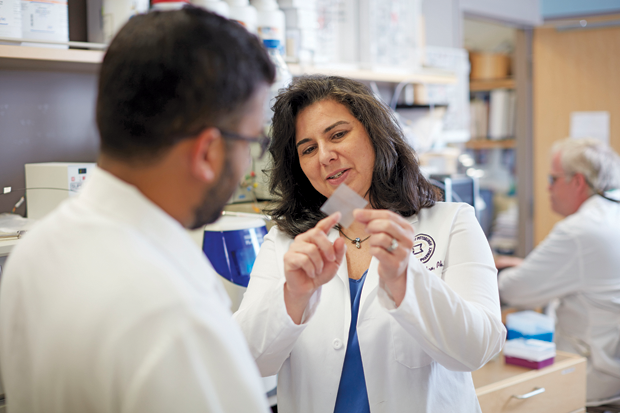Although women and men share many similar health challenges throughout their lifetimes, women are not necessarily healthier. Some conditions that only women experience—such as pregnancy, ovarian cancer, or the abnormal growth of the uterus called endometriosis—can become great health risks. HIV, AIDS, and sexually transmitted infections (STIs) are also serious medical and social issues for women worldwide. And because a woman’s reproductive system is complex and delicate—which makes it particularly vulnerable to dysfunction or disease—finding ways to treat conditions that take root in the reproductive tract often prove challenging.
However, in recent years, researchers have been investigating and developing new ways to administer medications for a range of women’s health conditions. These new methods aim to deliver drugs locally and so avoid metabolism by the liver or gastrointestinal tract as well as prevent patients from experiencing the drugs’ side effects. Scientists and drug developers are designing new gels, contraceptive devices that serve double duty in preventing against STIs, nanoparticles, and even robotic sperm to help prevent a range of health conditions women experience.
Double Duty

Because women are often confronted with both the need for contraception and protection from STIs, researchers are developing a range of multipurpose technologies (MPTs) that can address both these needs at once. “The ultimate MPT would offer broad-spectrum prevention for sexually transmitted disease and contraception,” says Thomas Zydowsky (Figure 1, right), an HIV and STI researcher at the Population Council, a reproductive health research center in New York City. While this technology is not yet widely available, different research groups are pursuing a range of approaches. Nearly all of these are still in development or in clinical trials; the most advanced have completed phase three trials. David Friend (Figure 2, below), the chief scientific officer of EvoFem, a San Diego, California, pharmaceutical company, hopes these technologies will be available for use in the next five to ten years.

Researchers and drug developers are prioritizing devices that can both prevent HIV and act as contraception [1]. However, it’s often challenging to combine other drugs having different physical and chemical properties with long-acting contraceptives.
At the Population Council, researchers are developing novel gel formulations that can offer protection against HIV, herpes simplex virus-2, and human papillomavirus, the last of which can lead to troubling forms of cervical cancer [2]. The gel, currently called PC-1005, is made of carrageenan, an additive that is known for its gelling and thickening properties and that homogenizes the mixture of drugs (Figure 3). The gel contains an acetate buffer with propylene glycol, the combination of which helps solubilize MIV-150, the microbicide used to prevent HIV. PC-1005 has passed phase one clinical trials, and the women who participated in the trial found it to be safe and acceptable for use.

At EvoFem, drug developers are working on a gel called Amphora to prevent not only pregnancy but also bacterial vaginosis—the most common vaginal infection in women aged 15–44. If left untreated, bacteria vaginosis can increase the risk of contracting HIV or other STIs, such as chlamydia and gonorrhea, or decrease a woman’s fertility. The gel is still in development and entering phase two clinical trials.
Beyond gels, other companies are adapting previous contraceptive devices like intrauterine devices or rings to hold drugs. But this can be challenging, Friend says. Many of the devices already on the market are made of silicon elastomers, but silicon is not a suitable material to control the release of other drugs over extended periods of time. To overcome these barriers, drug developers are creating devices that have a physical reservoir to hold drugs or designing segmented devices that can release multiple drugs at different rates.
CONRAD (for “Contraception Research and Development”), a Virginia-based company that specializes in reproductive health and HIV prevention, has been developing an intravaginal ring designed to protect against STIs and pregnancy. It contains levonogesterel, a hormone used for birth control, and tenofovir, an antiviral drug approved for treatment of HIV. It is currently being evaluated in a phase one clinical trial in the United States and the Dominican Republic.
Of the MPTs that are furthest along, researchers at the International Partnership for Microbicides, based in Silver Spring, Maryland, have developed a silicone dapivirine ring that protects against HIV and pregnancy. It is currently in phase three clinical trials.
Gelling With It

Similar to the ways that drug developers are working on gels that can protect a range of infections, pharmaceutical scientist Lisa Rohan and her colleagues at the University of Pittsburgh are developing vaginal films to protect against STIs (Figure 4). This method bypasses the need to take a pill or use physical protection like a condom, allowing application of the drug directly to the intended site of action. Rohan has found that small hydrophobic and hydrophilic molecules—such as polyvinyl alcohol, hydroxyprophyl methyl cellulose, and polyethylene glycol—may serve as a platform for drugs like dapivirine and tenofivir, both used to prevent HIV.
She and her colleagues have found that these films—Rohan describes them as similar to Listerine strips—can prevent viral infection in the same way as their pill equivalents. “You’re putting [the] drug right at the site where you’re infected, which limits systemic exposure to these active agents,” she says. “This is very important because it prevents against drug resistance and other side effects.” Not only has the method been efficacious in preventing infection; it’s also proven to be safe, and the women in the early trials found it unobtrusive.
Gaining Entry
Although directly applying drugs into the vagina can improve the treatment and prevention of many diseases, infections, and even cancer, the drug can only be efficacious if it enters the target cells. But getting drugs into vaginal cells can be challenging, especially with the mucus lining that’s naturally engineered to protect the vagina from foreign invaders.

To work around this obstacle, scientists are looking to encapsulate drugs within nanoparticles for delivery to vaginal and cervical tissues [3]. Whereas conventional nanoparticles stick to mucus, researchers are engineering nonmucoadhesive coatings to get drugs through a mucosal barrier or a tissue’s extracellular matrix. Depending on the drug that’s being encapsulated, drug developers need to tweak the nanoparticle formulation so it’s compatible with the properties of the drug, notes Laura Ensign, a drug delivery engineer at Johns Hopkins University in Baltimore (Figure 5, right). When developed properly, nanoparticles can provide a sustained and controlled release of drugs. Nanoparticles can also contain multiple compounds and have antimicrobial properties when combined with silver, a natural antibiotic.
So far, researchers have found that polyethylene glycol-coated nanoparticles can prevent the drug from interacting with the mucus lining. And, in general, “engineering the surface of the drugs so that they’re nonmucoadhesive seems to benefit the delivery of the drugs regardless of the type of therapeutic indication,” says Ensign. Drug developers have also found that polylactic-coglycolic acid—a polymer commonly used in biomaterials—can rapidly enter mucosal cells. Despite many laboratory studies, no nanoparticle-based drug formulations that target women’s reproductive health have entered clinical trials.
Future Spermbot Overlords
Within the last five years, German researchers have proposed a new way to treat cervical cancer: with robotic sperm [4]. Nestled deep inside the vagina, the cervix is relatively inaccessible; patients who suffer from cervical cancer often receive invasive surgery or take chemotherapy, which comes with a host of side effects.
In this new drug delivery model, the researchers think sperm could act as a vehicle for drug delivery, because the cells are already adapted to swim in the female reproductive tract. Sperm is also ideal for encapsulating, concentrating, and protecting drugs from degradation. And because sperm naturally fuses with other cells, they could potentially release drugs directly to the intended target cells.
Mariana Medina-Sánchez, a biomedical engineer at the Leibniz Institute for Solid State and Materials Research (IFW) Dresden, Germany, and her colleagues loaded sperm (derived from cattle) with doxorubicin, a widely used cancer drug. When administered systemically, doxorubicin causes a number of side effects, but the researchers hoped their approach would prevent this altogether. In tissue culture, they were able to successfully guide the sperm using a magnet toward the tumor, where they then freed the sperm cells to deliver the drug locally (Figure 6).
![Figure 6: A magnetic, sperm-driven micromotor technology is being developed at IFW Dresden in Germany. (Image courtesy of [4].)](https://www.embs.org/wp-content/uploads/2018/07/yan06-2833068.png)
While these experiments are still being performed in the lab, Medina-Sánchez believes that it would eventually be possible to deliver these types of engineered therapies to patients. She and her colleagues are still improving how the sperm is guided to the target tissues. In practice, a patient’s physician or another medical expert would be responsible for guiding the sperm. And, because it’s conceivable that the sperm could perform its natural function and fuse with oocytes, Medina-Sánchez believes it would be possible to treat a woman when she’s not ovulating. Looking forward, she and her colleagues are hoping to use the same robotic sperm technology to treat ectopic pregnancies and abnormalities in the epithelium of the uterus.
Although it’s currently unknown which technologies and methods of drug delivery will be approved and widely used in the future, researchers are investigating myriad methods. “Women like options,” says Rohan. “Even if we think about contraception: not everyone likes to take an oral contraceptive. Not everyone wants a ring. I think to be successful [in developing new methods for drug delivery], we need to have choices for women.”
References
- P. F. Harrison, A. Hemmerling, J. Romano, K. J. Whaley, and B. Young Holt, “Developing multipurpose reproductive health technologies: An integrated strategy,” AIDS Res. Treat., vol. 2013, Feb. 2013, doi: 10.1155/2013/790154.
- J. Kenney, R. Singer, N. Derby, M. Aravantiou, C. J. Abraham, R. Menon, S. Seidor, S. Zhang, A. Gettie, J. Blanchard, M. Piatak, Jr., J. D. Lifson, J. A. Fernandez-Romero, T. M. Zydowsky, and M. Robbiani, “A single dose of a MIV-150/zinc acetate gel provides 24 h of protection against vaginal simian human immunodeficiency virus reverse transcriptase infection, with more limited protection rectally 8-24 h after gel use,” AIDS Res. Hum. Retroviruses, vol. 28, no. 11, pp. 1476–1484 , Nov. 2012.
- L. M. Ensign, R. Cone, and J. Hanes, “Nanoparticle-based drug delivery to the vagina: A review,” J. Control. Release, vol. 190, pp. 500–514, Sept. 2014.
- H. Xu, M. Medina-Sanchez, V. Magdanz, L. Schwarz, F. Hebenstreit, and O. G. Schmidt, “Sperm-hybrid micromotor for targeted drug delivery,” ACS Nano, vol. 12, no. 1, pp . 327–337, 2017.



